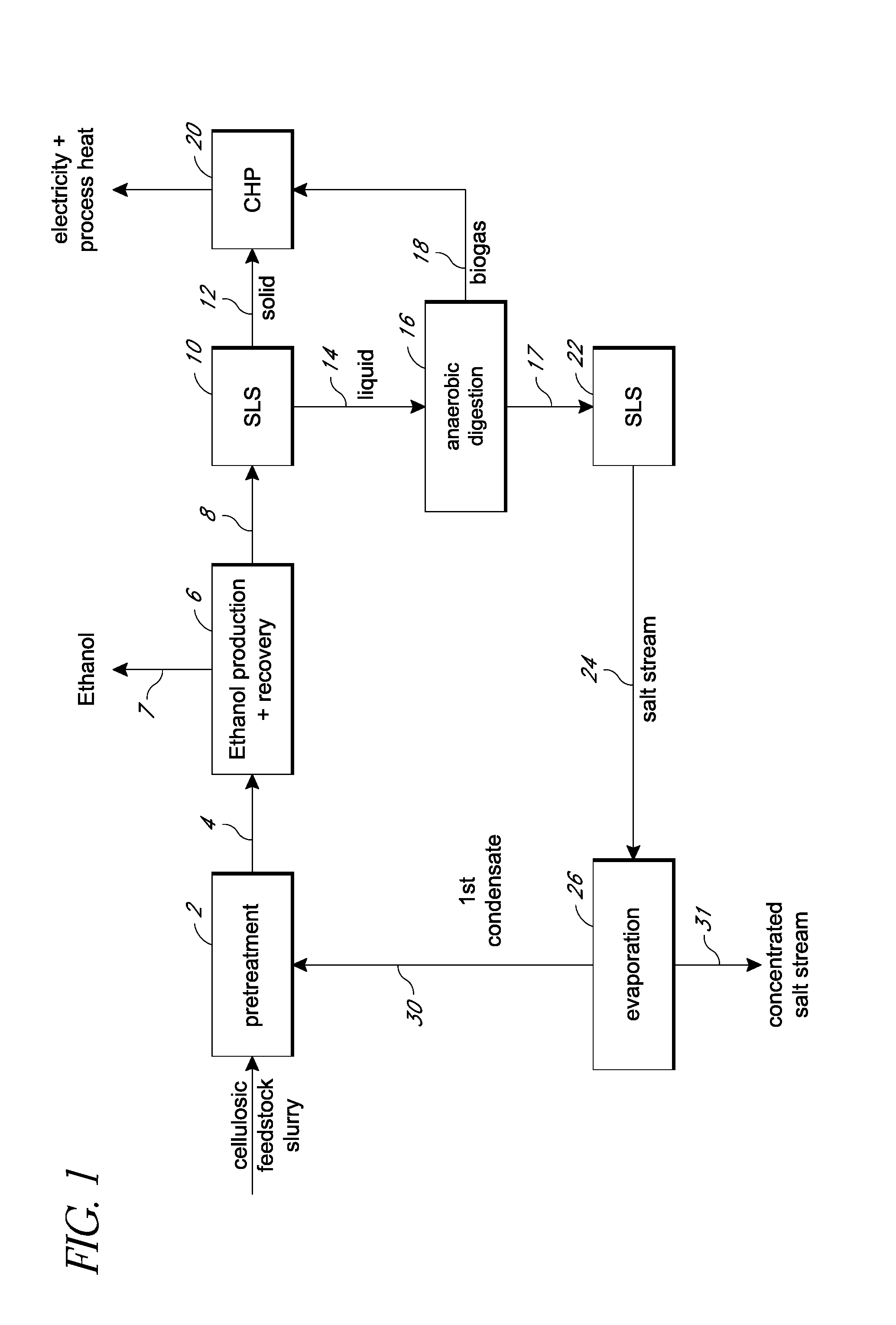Production of products with favourable ghg emission reductions from cellulosic feedstocks
- Summary
- Abstract
- Description
- Claims
- Application Information
AI Technical Summary
Benefits of technology
Problems solved by technology
Method used
Image
Examples
example 1
Description of a Comparative Process
[0200]As noted, in the comparative process illustrated schematically in FIG. 1, evaporation is conducted on the complete salt-containing liquid stream from the digester rather than a portion of the stream. Condensate from steam condensed in the evaporator is then recycled to the various stages of the process. As illustrated below, evaporating the whole salt-containing stream, rather than a portion thereof, and recycling only condensate is energy intensive and increases the GHG emissions of the process.
[0201]As shown in the comparative process of FIG. 1, a cellulosic feedstock slurry, in this case switch grass, is subjected to an extractive releasing step, in this case a pretreatment 2 which involves, for example, the addition of pretreatment chemical, such as acid, and heat to hydrolyze at least a portion of the xylan component of the cellulosic feedstock to release xylose and organic acids. The resultant pretreated cellulosic feedstock slurry 4 i...
example 2
Description of an Embodiment Employing Water Recycle
[0207]As noted above, embodiments of the invention involve purifying biogas from anaerobic digestion and introducing it to a pipeline from which methane is withdrawn for use as a transportation fuel. The GHG emissions associated with purifying the biogas from anaerobic digestion and introducing it to a pipeline result in a reduction to the life cycle GHG emissions per unit of fuel produced. This is off-set by the reductions in GHG emissions resulting from evaporation of a purge stream rather than evaporating a complete salt-containing stream, as in the comparative process of FIG. 1 (stream 24 of FIG. 1). As described in more detail in Example 3, because of this off-set in GHG emissions, the life cycle GHG emissions relative to a gasoline baseline are significantly more favourable than that of the comparative process of FIG. 1.
[0208]An example of a process carried out in accordance with embodiments of the invention is described with...
example 3
Life Cycle GHG Emissions of Comparative Process Versus an Embodiment of the Invention
[0216]The life cycle GHG emissions (relative to a gasoline baseline) associated with the comparative process described in FIG. 1 and the inventive process described in FIG. 2 were calculated. For the comparative process of FIG. 1, the life cycle GHG emission savings relative to a gasoline baseline were 66%. However, implementing the process steps of the inventive example described in FIG. 2 increased the GHG savings to 73% relative to a gasoline baseline.
[0217]The analysis is described in more detail in Table 3 below. First, the GHG emissions of the comparative process in which crude biogas was fed to a boiler (in this case a combined heat and power unit 20) were quantified. The results are set forth in Part A of Table 3 below. This included quantifying emissions upstream and downstream of the plant, namely process emissions from agriculture, land use changes, feedstock and fuel transport and tailpi...
PUM
 Login to View More
Login to View More Abstract
Description
Claims
Application Information
 Login to View More
Login to View More - R&D
- Intellectual Property
- Life Sciences
- Materials
- Tech Scout
- Unparalleled Data Quality
- Higher Quality Content
- 60% Fewer Hallucinations
Browse by: Latest US Patents, China's latest patents, Technical Efficacy Thesaurus, Application Domain, Technology Topic, Popular Technical Reports.
© 2025 PatSnap. All rights reserved.Legal|Privacy policy|Modern Slavery Act Transparency Statement|Sitemap|About US| Contact US: help@patsnap.com



